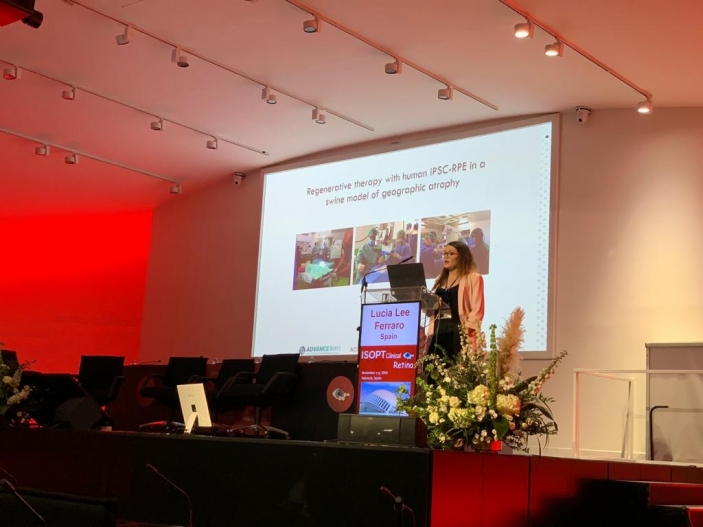Dr Ferraro presents at the 15th ISOPT the results of the project on cell therapy with Retinal Pigment Epithelium (RPE)

The ophthalmologist and researcher of the Barcelona Macula Foundation, Dr Lucia Lee Ferraro MD, was a protagonist at the prestigious ISOPT Clinical, held in Valencia on November 7-9. She gave a lecture connected to the ADVANCE (CAT) project, of which the BMF forms a part, and the research project on cellular therapy with RPE
On November 7-9, the 15th International Symposium on Ocular Pharmacology and Therapeutics Clinical: The Retina Chapter (ISOPT Clinical) was held in Valencia, providing a meeting point for discussing the current status and advances in the therapeutic techniques and treatments in this specialty. This year’s event focused on the medical treatment of retinal pathologies.
The ophthalmologist and researcher of the Barcelona Macula Foundation, Dr Lucia Lee Ferraro MD, presented “Transplantation of human iPS cells-derived RPE cell suspension into the subretinal space of a swine model of geographic atrophy”, a research project exploring a treatment for the dry form of macular degeneration.
The project is linked to the ADVANCE (CAT) Consortium of which the Barcelona Macula Foundation and the Center for Regenerative Medicine of Barcelona (CMRB) form part. It has demonstrated that retinal pigment epithelial cells derived from implanted human induced pluripotent stem cells (hiPSC- RPE) are able to integrate into the healthy retina and form an epithelial monolayer, mainly in healthy retina and in the margins of the atrophic zone. In addition, some histological sections show a possible interaction between transplanted stem cells and photoreceptors.
Stem cells perform two important functions. The first is the production of neurotrophic growth factors that support damaged retinal cells. Secondly, stem cells integrate by supporting other pigment epithelial cells. These results might enable us to deduce that the use of stem cells slows the progression of macular degeneration, especially in the early stages of the disease.
The ADVANCE (CAT) project set as its principal aim the development of medicines for human use from preclinical phases to clinical application, based on genes (gene therapy), cells (cell therapy) and tissues (tissue engineering), i.e. the development of advanced therapies. For this, the project boasted a network of Catalan entities from the field of biomedical research, including the BMF, together with the Universitat de Barcelona (UB), Ferrer International (Ferrer), the Banc de Sang i Teixits (BST), the Leitat Foundation, Bioiberica, the CMRB, the August Pi i Sunyer Biomedical Research Institute (IDIBAPS), the Bosch i Gimpera Foundation (FBiG) and the Health Sciences Research Institute of the Germans Trias i Pujol Foundation (IGTP).
From the outset, it was very important in the ADVANCE(CAT) project to foster collaboration between research centres, academics and companies from the sector in order to create new drugs based on advanced therapies and lead them towards clinical and industrial application. The project has formed part of the Action Plan of the RIS3CAT Community ‘NEXTHEALTH: multidisciplinary solutions for the coming challenges in health‘. This is coordinated by Biocat, promoted by ACCIÓ (Catalonia Trade & Investment; the Government of Catalonia) and funded by the European Union as part of the ERDF (European Regional Development Fund) operational programme, Catalonia 2014-2020.

In addition to this lecture of Dr Lucia Lee Ferraro MD, the Barcelona Macula Foundation was also represented by the retinologist Dr. Jordi Mónes MD, PhD, Director, principal investigator and one of the foundation’s founding trustees.
Dr Monés gave three lectures. The first, titled “Simultaneous neutralization of angiopoietin-2 (Ang-2) and vascular endothelial growth factor-A (VEGF-A) with faricimab: a review of the phase 2 clinical trials in neovascular age-related macular degeneration (nAMD) and diabetic macular edema (DME)”, addressed the status of the Lucerne and Rhine clinical trials. The other two, “Review the pathogenesis of AMD and the pathways to CNV and GA” and “Novel gene therapy approaches for inherited retinal diseases“, respectively analysed the physio-pathological causes of advanced macular degeneration and gene therapy for hereditary retinal diseases.